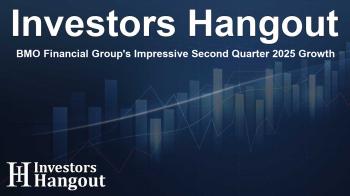BMO Financial Group's Impressive Second Quarter 2025 Growth

BMO Financial Group's Financial Results Snapshot
BMO Financial Group has made headlines with its remarkable financial results for the second quarter of 2025. The unaudited interim consolidated financial statements for this period highlight a strong performance that continues to position BMO as a leader in the financial sector. This comprehensive report reflects the company's dedication to achieving its goals and adapting to changing market conditions.
Financial Performance Overview: Q2 2025 vs Q2 2024
Key Metrics and Achievements
The reported net income for the second quarter is a significant $1,962 million, outperforming last year's $1,866 million. Adjusted net income was reported at $2,046 million, as opposed to $2,033 million from the previous year. This growth underlines BMO's strategic focus and effective management of resources.
The earnings per share (EPS) have seen an upward trajectory, with reported EPS rising to $2.50 from $2.36 in the same quarter last year. The adjusted EPS also increased, reaching $2.62, compared to $2.59 previously. Such increases are positive indicators of the company's robust health and market positioning.
The provision for credit losses (PCL) was $1,054 million, an increase from $705 million the prior year, reflecting a cautious approach amidst economic uncertainty. The return on equity (ROE) reported at 9.4% demonstrates a slight decrease from 9.9% last year, but the adjusted ROE of 9.8% remains competitive.
2025 Year-to-Date Financial Overview
Comparative Year-on-Year Analysis
For the year-to-date examination, BMO's reported net income soared to $4,100 million from last year’s $3,158 million, demonstrating strong growth. Adjusted net income reached $4,335 million, compared to $3,926 million for the same period last year, exemplifying the company's effective strategies in capitalizing on growth opportunities.
The EPS for this period increased significantly to $5.34 compared to $4.08 last year, with adjusted EPS at $5.66 versus $5.14. This reflects favorable market dynamics and the company’s ability to manage risks effectively within its operational framework.
Segment Performance Breakdown
Review of Operational Segments
The Canadian P&C segment reported a net income of $782 million, although this was a decrease from the previous year due to increased expenses and PCL. Meanwhile, the U.S. P&C segment showed resilience with a slight net income rise to $546 million. BMO Wealth Management experienced a robust net income increase to $361 million, while BMO Capital Markets recorded $431 million despite challenges.
Capital Position and Shareholder Returns
Commitment to Growth and Shareholder Value
BMO's Common Equity Tier 1 (CET1) Ratio stands at 13.5%, indicating a strong capital position. Achieving a quarterly dividend of $1.63 per common share, representing a 5% increase, the bank continues to show its commitment to returning capital to shareholders. This figure reflects both stability and strategic inclination towards enhancing shareholder returns, even amidst fluctuating economic conditions.
During the quarter, BMO initiated a share repurchase strategy, acquiring 7 million common shares under its normal course issuer bid, further advocating for shareholder value maximization.
Conclusion and Future Outlook
Looking ahead, BMO Financial Group remains bullish about its prospects, driven by strong revenue growth and prudent risk management strategies. The management's focus on optimizing the balance sheet and investing for long-term growth continues to position the company favorably in a competitive landscape.
Frequently Asked Questions
1. What financial performance did BMO achieve in Q2 2025?
BMO reported a net income of $1,962 million for Q2 2025, reflecting a solid year-over-year growth.
2. How did the earnings per share change?
The earnings per share increased to $2.50 in Q2 2025, up from $2.36 in the same period last year.
3. What was the provision for credit losses for the quarter?
The provision for credit losses was $1,054 million, which shows an increase compared to the previous year's $705 million.
4. How has BMO's capital position been impacted?
BMO's CET1 ratio stood at 13.5%, demonstrating a healthy capital position amidst ongoing market challenges.
5. What future steps is BMO planning?
BMO plans to focus on optimizing its balance sheet and investing strategically for growth while providing returns to shareholders through dividends and share buybacks.
About The Author
Contact Owen Jenkins privately here. Or send an email with ATTN: Owen Jenkins as the subject to contact@investorshangout.com.
About Investors Hangout
Investors Hangout is a leading online stock forum for financial discussion and learning, offering a wide range of free tools and resources. It draws in traders of all levels, who exchange market knowledge, investigate trading tactics, and keep an eye on industry developments in real time. Featuring financial articles, stock message boards, quotes, charts, company profiles, and live news updates. Through cooperative learning and a wealth of informational resources, it helps users from novices creating their first portfolios to experts honing their techniques. Join Investors Hangout today: https://investorshangout.com/
The content of this article is based on factual, publicly available information and does not represent legal, financial, or investment advice. Investors Hangout does not offer financial advice, and the author is not a licensed financial advisor. Consult a qualified advisor before making any financial or investment decisions based on this article. This article should not be considered advice to purchase, sell, or hold any securities or other investments. If any of the material provided here is inaccurate, please contact us for corrections.

